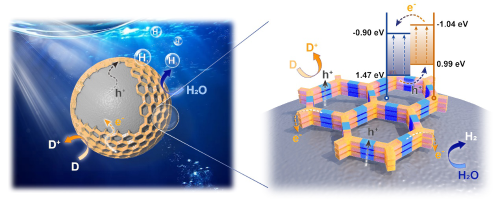
-
Towards high-efficient photocatalytic H2 production: Using COF nanoshells to modulate the transfer process of electron, hole and proton
2021-08-20
Designing high-efficient photocatalysts with superior structure-performance relationships is of great significance in the photocatalysis field. Generally, the photocatalytic process involves the generation, transport, and utilization of photo-generated electrons, along with the transport of reactants and products. Therefore, it becomes one of the most important issues to well coordinate the transport of charge and reactants/products for boosting the photocatalytic activity.
The core–shell structured photocatalyst, which consists of an inner core shielded by an outer shell, can impart highly tunable heterogeneities and functionalities, affording a powerful platform to coordinate the charge transfer and molecule diffusion. As we know, the outer shell plays an important role in a core-shell structure. Compared with the dense shell, the porous shell holds greater promise owing to the superiority in enabling the unimpeded light capture as well as the free diffusion of reactants/products. The last few years have witnessed the rapid development of covalent organic frameworks (COFs) and their exceptional potential in photocatalysis due to all-organic feature, long-range ordered structure, specific active sites, tunable pore size and high porosity, diverse reticular chemistry. Accordingly, the emergent COF materials offers a new opportunity for the rational design and delicate regulation of the shell structure in the core-shell photocatalyst.
Aiming at coordinating the charge transfer and molecule diffusion, in the paper published by scientists from Tianjin University in China, the COF nanoshell was first bottom-up synthesized on the surface of cadmium sulfide (CdS) nanospheres to construct independent transfer pathways through the core-shell CdS@COF nanospheres.
A typical COF material, TPPA, featuring high stability in water, acid and base, was synthesized through the interfacial polymerization using 1, 3, 5-triformylphloroglucinol (TP) and p-phenylenediamine (PA) as monomers. The TPPA nanoshell endows the CdS@TPPA nanosphere with ordered channels (1.8 nm) for unimpeded light capture and free diffusion of protons and molecules. Benefiting from the well-defined modular building blocks (PA as electron donor, and TP as electron acceptor) in the framework, the TPPA nanoshell also affords a preorganized transport pathway for electrons and holes to separate spatially. Moreover, the heterojunction formed between CdS and TPPA can further facilitate the effective charge separation at the interface via lower exciton binding energy (ΔEb=37.3 meV) compared with that of pristine TPPA. Three transport pathways respectively for the electron, hole and reactants/products were constructed via the TPPA nanoshell, ultimately enhancing the overall photocatalytic activity. The thicknesses of COF nanoshells was tuned from 5±1 to 8±1 and 11±1 nm by varying the amounts of two monomers. With the optimal thickness (8±1 nm) of COF nanoshells, the CdS@TPPA nanosphere photocatalyst achieves the highest hydrogen evolution rate up to 24.3 mmol g-1 h-1, which is about 80 and 15 times higher than those of pristine COF and CdS, respectively. The corresponding apparent quantum efficiency (AQE) is 4.29% at 420 nm, which is competitive among those of reported COF-based photocatalysts. In addition, it is noted that this photocatalysts without using any co-catalysts still show superior hydrogen evolution activity (0.995 mmol g-1 h-1), which further confirms their great potential in practical application.
Image:This is the schematic illustration for the photocatalytic hydrogen evolution mechanism over the core-shell CdS@TPPA nanosphere.
The framework nanoshell in this work may stimulate the thinking about how to design advanced shell architecture in the core-shell structured photocatalysts to achieve the rational synergy of charge and molecule transport. Considering the vast number of monomers available for organic framework construction and rapid advances in reticular chemistry, we believe that the organic framework nanoshell will evolve a powerful platform design.
Tag: Advanced Materials
Source: https://spj.sciencemag.org/journals/research/2021/9798564/
